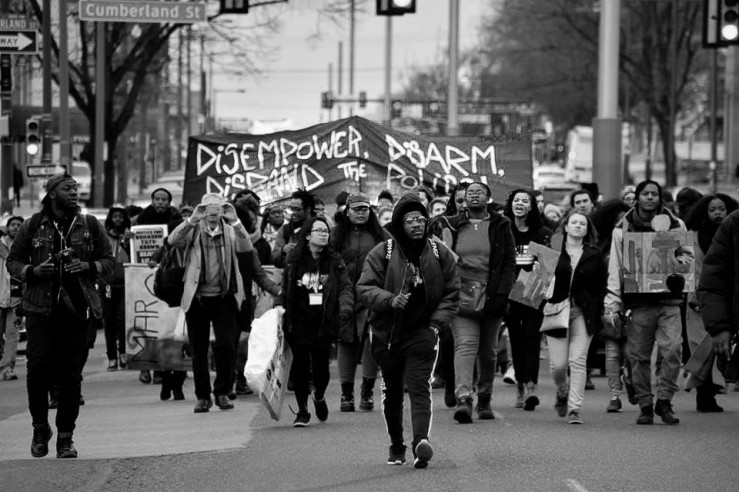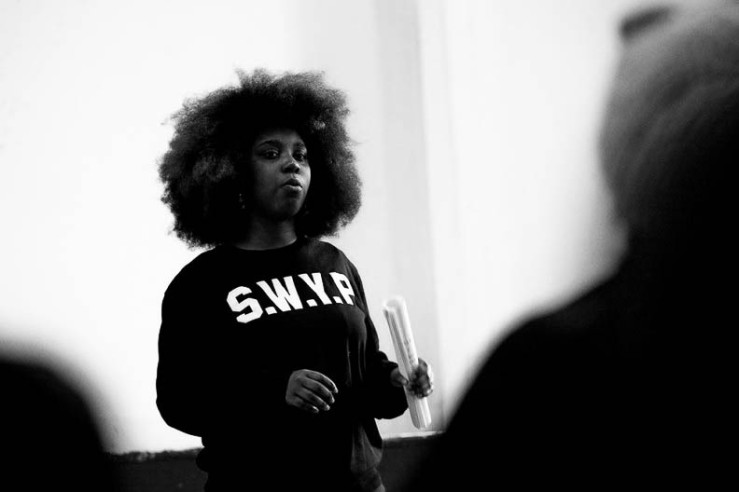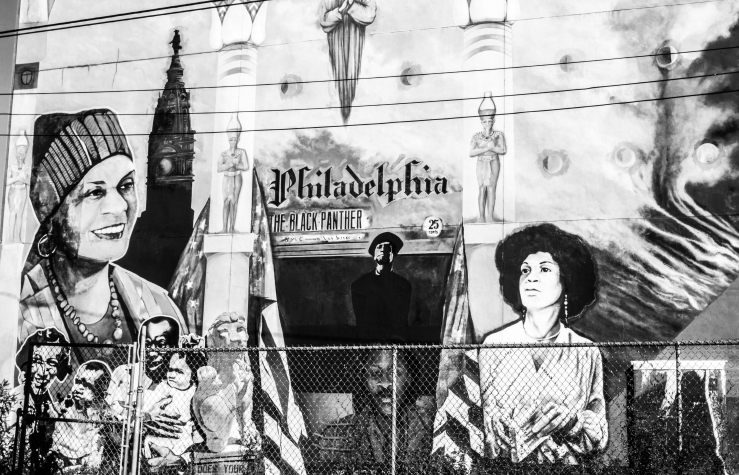Since the second day of the Black Radical Tradition Conference, there was a strange but seemingly coordinated effort to disrupt the conference. BROC held a dialogue with the disruptors on the third and final day of the conference to understand what their grievances were. While BROC did not get the chance to undertake an independent investigation of what had happened, we released this statement as a conclusion of what had happened.
The Black Radical Organizing Collective (BROC) held a powerful conference that drew from many parts of the movement for Black liberation. We understood the fundamental principle that the people united will never be defeated and our program reflected the importance of principled unity in the face of capitalism and white supremacy in crisis. We invited a diverse host of speakers because we wanted a robust dialogue of different ideological orientations in the movement. Throughout the conference, we wanted to emphasize the importance of unity and solidarity in strengthening the victory of revolutionary movements, which is foundational to the Black Radical Tradition. Inevitably, our dedication to principled unity provoked an identitarian counter-revolutionary tendency of people dedicated to disrupting the conference and undermining the unity for which we had tirelessly worked in the months preceding the conference.
The pattern of disruption started with claims that Black people were being denied seats at the conference and the community wasn’t being heard. The Black Radical Tradition Conference was free of cost, and nobody was turned away from the conference. Because the main hall could not accommodate all of the people that came to the conference, attendees were sent to satellite locations where they could watch a livestream of the conference. Conference attendees had been notified in advance of the seating arrangement via email and the conference website. Priority registrants were guaranteed a seat at the people’s assemblies, but the panels were first-come, first-serve. If priority registrants did not show up, people on standby would be seated in the 15 to 20 minutes before each assembly. Because the conference was free of cost, we had to be disciplined about seating and consistent with what we had promised.
Additionally, the conference was a force of the Black Philadelphia community with our primary sponsor being the historical Church of the Advocate of North Philadelphia, which hosted the National Conference of Black Power in 1968 and the Black Panther Conference in 1970. BROC is a grassroots collective working on a limited budget and we do not enjoy substantial institutional funding. We held the conference at Temple University to challenge its racist and colonialist gentrification of North Philadelphia and its destruction of the African American Studies program. We, ourselves, were not Temple University, and we risked Temple shutting down the conference and kicking us out at their leisure. The subversive power of occupying space at Temple had been established by Kashara White, Anthony Monteiro and Cornel West at the first people’s assembly on Friday night, January 8. The conference empowered the voices of the community and illuminated Black Philadelphia—a vilified, criminalized and oppressed people—to a national audience, and showed a racist institution that its policing and gentrification would not diminish the resistance of the people.
Nevertheless, the conference experienced a pattern of disruption. People involved in the disruptive behavior showed contempt for conference organizers and the discipline with which we facilitated the program. Whether the people involved were misguided or unintentional in their behavior, their actions were not respectful, preventing the productive resolution of difficulties. BROC firmly believes revolutionary love for the people inspires discipline, humility and respect, and that the opposite exposes a lack of love for the people. We faced groups of people that failed to practice precisely this revolutionary fundamental and exposed themselves as counter-revolutionaries.
A group of people continually asked white people in the main hall to give up their seats for Black people in satellite rooms, even though white people constituted a minority in the main hall. They did this while the panels and assemblies occurred, distracting the audience and speakers. They were asked multiple times to stop by the organizers, but they persisted. This pattern of disruption culminated in the “Challenging White Supremacy” people’s assembly. A couple of individuals began screaming outside the main hall, interrupting the assembly and causing a few people to rush out of their seats, three of whom were BROC members. Fearing that a fight had broken out or the individuals were in distress, we learned they had in fact staged a disruption over seating.
The disruption disrespected the speakers, distracted the audience and posed a safety hazard. It could have provoked a physical altercation, and if more people had rushed out of their seats, a stampede could have occurred. The safety of renowned activists in the room was also at risk. After all, Malcolm X’s assassination occurred after a staged disruption in 1965, and Huey P. Newton was forced to abandon a speech he was supposed to give in 1970 because he knew counter-revolutionaries planned on assassinating him from the audience.
While we do not know if the group staging the disruption were agent provocateurs, they operated as if they were agent provocateurs. They worked against the wishes of conference organizers and volunteers on a highly premeditated level, and they were extremely calculated in disrupting the program and frustrating our arrangements. They sought to sabotage the conference and divide the people that attended, making difficult the building of principled unity in the movement. So while we do not know if they were agent provocateurs, their behavior caused BROC to treat them as such in guaranteeing the success and viability of the conference and the safety of attendees.
The pattern of disruption reached its most intense point on the third day, January 10. The same group of people, who were disruptive about seating, staged a protest inside Anderson Hall. They used an incident of transphobia at the Queer Resistance panel to protest with chants and posters. From the beginning, the panel was stated to be a safe and brave space, making disagreement inevitable, but cultivating respect and learning amidst differences. When a cisgendered homosexual panelist said transphobic slurs, using them as examples of transphobia she had witnessed growing up, people in the audience were understandably upset. The panelist was unaware people were sensitive to the slurs and apologized many times. While BROC was not in total control of what speakers chose to say on panels, BROC member and moderator, Gabe Gonzalez, personally apologized to the people upset by the slurs. The group disregarded the apology and used transphobia as the pretext to protest the entire conference.
The disruptive protest was a reactionary and ultraleftist move that risked shutting down the entire conference and summoning the police.[1] BROC did not control Allied Barton security,[2] workers employed by Temple who make below a living wage, and Temple police. Temple police wanted to call reinforcements to remove the protesters from the building, but BROC explicitly told them not to call more police.[3] We decided to hold a dialogue with the protesters, rather than expose them and other attendees to the violence and brutality of the police.
BROC held the dialogue with the disrupters in a spirit of revolutionary love and unity. The primary grievance that arose pertained to the issue of seating and the idea that the conference should have been a Black-only space. BROC never intended to put on a Black-only conference and we were explicit in our Call to Action on the crucial importance of multiracial and internationalist solidarity in the struggle for Black liberation: “The Black Radical Tradition embraces commitments to the unity of the people. It has in the past and today stands with all victims of white supremacy and capitalist hierarchies and oppressions. It is part of the common resistance of all peoples of color, working people and the poor. It is internationalist, at home and abroad. It stands with all genuine efforts of Pan-Africanism, Afro-Asiatic, Afro-Indigenous and Afro-Latino unity. . . The Black Radical Tradition is welcoming and open.”
The Black Radical Tradition is foundational to people who are not Black, for it is only with the liberation of Black people that humanity can be freed from its chains of oppression, just as Black people cannot be liberated while humanity is in chains. The disrupters signaled an ideological split in the movement between reactionary division and revolutionary solidarity, not unlike the historical split between counter-revolutionary cultural nationalists like Ron Karenga, Molefi Asante, and US[4], and radical socialist organizations like the Black Panther Party and Fannie Lou Hamer’s Mississippi Freedom Democratic Party.
We view this trend of identity politics in the movement and the insistence on Black-only spaces as a re-manifestation of cultural nationalism and an ultimately divisive and dehumanizing force. We agree with Anthony Monteiro’s analysis that identity politics is the reconfiguration of whiteness and uses Western liberal conceptions of race to characterize Black identity, instead of dismantling whiteness and Americanism, and practicing a genuine politics of solidarity to liberate humanity from tyrannical systems of capitalism, racism, colonialism, patriarchy and imperialism.
As a collective, we seek to continue the legacy of the Black Panther Party, which embraced white and other nonblack allies in their struggle and practiced internationalism. The Black Panthers struggled with some Black students who opposed their coalition-building with white and nonblack people. Huey P. Newton writes in Revolutionary Suicide, “We maintained this was possible as long as we controlled the programs, but the students were opposed to working with white groups, or, for that matter, almost anyone but Blacks. While this viewpoint was understandable to me, it failed to take into consideration the [strategic] limitations of our power. We needed allies, and we believed that alliances with young whites—students and workers—were worth the risk” (182). And as Angela Davis reminded us at the conference, the contribution of nonblack revolutionaries like Grace Lee Boggs and Yuri Kochiyama at the prerogative of Black leaders is invaluable to the Black Radical Tradition.
BROC believes that a Black Power space is different from a Black-only space. While white and nonblack people were in attendance, they constituted the minority and Black people dominated the conference. We believe Black people dominating a space with white and nonblack people is more revolutionary than a Black-only space, which is insular and ignores the reality of the world outside the safe space. As Assata Shakur writes in her autobiography, “I believe in uniting with white [and nonblack] revolutionaries to fight against a common enemy, but I was convinced it had to be on the basis of power and unity rather than from weakness and unity at any cost” (192). The Black Radical Tradition Conference allowed the attendance of nonblack people from the position of power and unity for Black people, who were centralized and empowered at this conference.
Power and unity form the principle in our struggle going forward. We believe the Black Radical Tradition Conference marks the next phase in the struggle for Black liberation in the United States. The disruption showed us where some people were at in the movement, and it convinced us of the importance in revolutionary education for all the people. But we wish to ask: Was this pattern of disruptive behavior politically motivated? And what does that mean for the movement at large?
Nevertheless, we believe the people united will never be defeated, and our conference triumphed in spite of the elements that tried to stop it.
[1] Because the protest was inside the lobby of the building, police and security aimed to remove the protesters from the building.
[2] BROC hired an independent security force for the conference, which was distinct from the security employed by Temple University, and who were not involved in calling Temple police.
[3] Temple police disregarded our wishes and called reinforcements anyway. But they left, because we held a dialogue and the protest desisted.
[4] Karenga and US colluded with the police state and killed two Black Panthers, John Huggins and Alprentice “Bunchy” Carter. Likewise, Asante joined forces with Temple to initiate Monteiro’s firing and removal from the African American Studies department.




